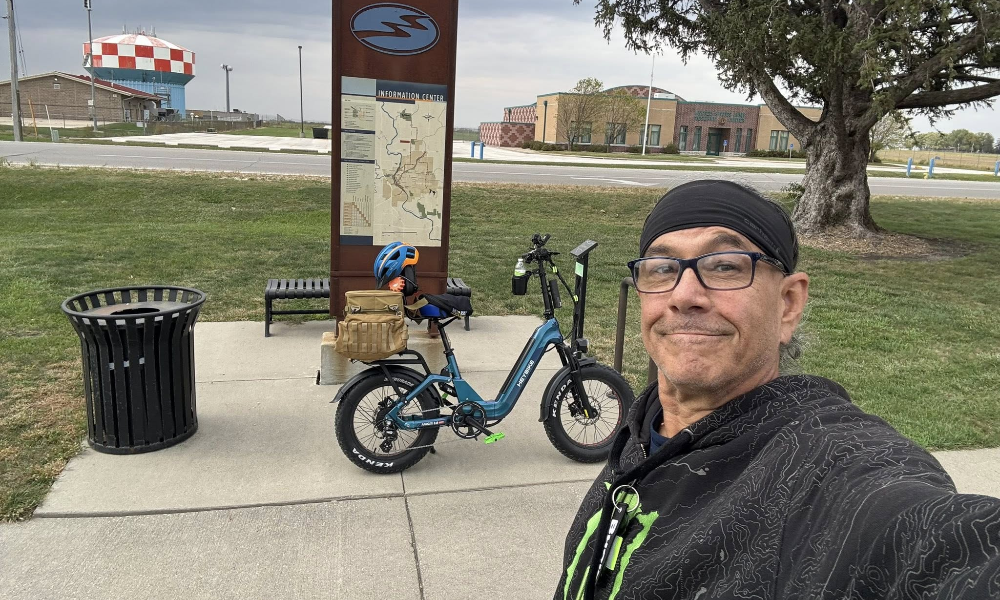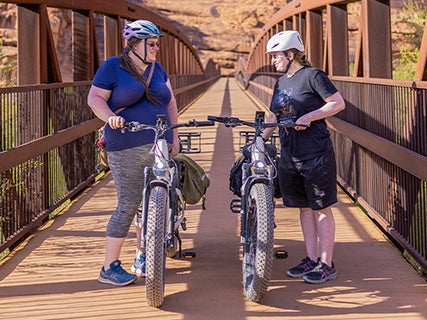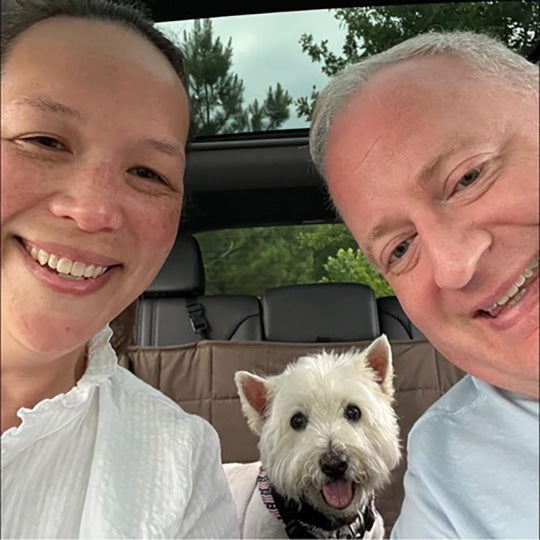Are you considering taking your kids on an e-bike? If so, you need to decide where to put them. There are two main options: front or rear seats. But which is the best option for security? In this article, we'll compare the pros and cons of front- and rear-facing seats so you can make the best decision for your child.
Is Biking With Your Child Safe?
Bicycling with a child as the passenger can be a heated discussion. It's crucial to realize that bike riding with a child is not like riding alone. Balancing will be altered, making dismounting and mounting the bike more challenging. Incidents involving children in their bike seats happen while getting off and on the bike, so proceed with caution and possibly seek assistance until you are confident doing it independently.
You might also anticipate moving at a steady and slower speed and stopping more frequently than usual. Riding at high speeds through uneven trails isn't something you'll do. Even though most parents are aware of this, it's still worth addressing.

A child passenger on an adult's bike causes the bike to become unstable and lengthens the time it takes to stop. A collision during casual riding could result in serious injury to the child. Following these principles reduces the risks of accidents:
- A little passenger should always use a lightweight bike helmet to minimize or avoid head injury.
- Only adult and experienced cyclists should transport children.
- Infants under the age of twelve months are too young to ride on the back of a bicycle. On a bike, do not transport infants in front packs or backpacks.
- Ride with passengers in parks, bike paths, or quiet streets. Avoid congested areas and inclement weather, and ride with extreme caution and at a low pace.
- Children are old enough to sit correctly independently (twelve months to four years) and whose head and neck are strong enough to handle a lightweight helmet can be transported in a rear-mounted seat or child trailer.
Standards for Rear-Mount Bike Seats
The child bike seat of today is a significant improvement over what many Gen X and millennials rode about 30 years ago. With the backside extending beyond the head and side supports, rear-mounted seats provide outstanding stability, cushion, and head support. Unlike front-facing seats, most rear-facing seats can accommodate youngsters weighing 70 pounds.
This standard applies to child carriers attached to the back of a bicycle. Sharp points and sharp edges must not be present in the carrier, and if they are, they must be appropriately covered with protective coatings to prevent damage. A rear reflector, footrests, backrests, armrests, protection devices to keep the children's hands and feet from coming into contact with moving or moveable components of the bicycle, and belt or catching devices to restrict the child from standing in or leaving the carrier are also required.
The Pros and Cons of the Different Types of Bike Seats
Pros and Cons of Front-Mounted Seats
Front-mounted seats are fastened to the base of the handlebars and are located in the front of the bike. The rider has constant visual contact with the child in this posture. Additionally, while riding, both arms surround the seat. Children aged nine months to three years old should use the front-mounted seats. If the rider is excessively short, the front seat can make visibility difficult. Raising the seat level may appear viable, but the rider may struggle to reach the pedals.
Pros
- At all times, you can see your child.
- You and your child can easily communicate.
- You can easily anticipate weight adjustments along the route, avoiding road bumps for you and child.
- Your child will have a clear view of the surroundings.
Cons
- Your child may obstruct your steering.
- A front-mounted seat shifts the bike's center of gravity, making handling more challenging and dismounting more difficult.
- There may be less space between the knees and the pedals.
Pros and Cons of Rear-Mounted Seats
Rear-mounted seats are located behind the seat on the back of the bike. They can be mounted to the seat tube or a rear rack directly. Particularly for people who don't have eyelets on their seat stays. Furthermore, not all rear racks are suitable for bikes with disc brakes. A rear-mounted child bike seat is ideal for children aged 9 to 12 months and weighing up to 48 pounds. It is preferable to get the best bike trailer for children if your child is five years old and weighs more.
Pros
- With the child seat behind you, it's easier to ride and get on/off your bike.
- Many rear-mounted seats recline to provide a more pleasant sleeping environment for the baby.
- Your child is protected from the wind.
- Most rear-mounted seats will last longer than front ones.
Cons
- When it's windy or noisy, it's more difficult to converse with your child.
- Without turning around, you can't gaze at your child.
- Your child cannot lean forward due to a lack of a pillow.
Pros and Cons of Bike Trailers
Over the last decade, the pull-behind bike trailer has become a rarity to commonplace, especially on limited-access routes and other places where the perceived risk is minimal. It's simple to see why: a trailer is safer than a high-mount bike seat, but it also allows active parents to keep busy when their children aren't ready to pedal at a steady pace. Trailers have become somewhat specialized in recent years, similar to the rest of the cycling hobby, with off-road-focused models finding momentum in the market.
Pros
- The trailer can accommodate many children, ideal for twins or children of varying ages.
- There will be no danger of your child falling.
- Trailers provide the utmost comfort. Your youngster is welcome to bring their toys along for the voyage.
- You may concentrate on your cycling.
- Because children can easily fall asleep during the journey, you can embark on longer rides, even touring.
Cons
- If you don't have a lot of space or a garage, it might be tough to store, and you may need a place to leave the trailer if you're dropping kids off at nursery or school and don't want to ride it to work.
- You won't be able to keep an eye on your youngster.
- It is impossible to communicate.
- During the ride, your youngster will miss out on the opportunity to be entertained.
- A trailer is a more expensive investment, but you might be able to find one used.
Factors to Consider When Choosing a Bike Seat
1. Consider the Types of Child Bike Seats
Kid's bike seats come in three styles: front-mounted, rear-mounted, and center-mounted. A bike seat mounted on the front handlebars is a front-mounted bike seat. A bike seat mounted over the crossbar in front of the rider is known as a center-mounted bike seat. A bike seat positioned over the back wheel behind the rider is a rear-mounted bike seat. Children on a bike seat should be between one and four. However, because children develop at various speeds, this can differ.
2. Child's Age and Weight
Consider your child's age and weight when deciding the child bike seat to purchase. In this way, front-mounted and rear-mounted baby seats differ significantly. Child bike seats in the front are often considerably smaller than those mounted in the back. Most models are suitable for children aged 9 months to 5 years old and weighing up to 33 pounds. Taller and older children should avoid these seats because they take up a lot of room in front of the user and make riding difficult.
Child bike seats attached in the back are substantially more prominent, making them ideal for older and heavier children. They are typically designed for children aged nine months to 6-7 years. Their maximum weight capacity is roughly 48 pounds on average. It's important to remember that wearing a helmet on a child under 12 months is not recommended, so you should think twice about bringing them for rides if they're younger than that.
3. Suspension
Suspension is a crucial element of bike seats that few models provide. Suspension is not available on front-mounted chairs. However, it is available on some rear-mounted seats. The metal bars that link the seat to the frame in rear frame-mounted seats are engineered to flex under tension, acting as suspension. Driving over potholes, curbs, or other irregularities reduces vibrations and impact. Dual-spring suspension, which flexes 1'' to 1.5'' and makes the ride smoother and less twitchy, is available on some rear rack-mounted seats. It's unquestionably a bonus.
4. Safety Features
When it comes to using a child bike seat, parents' primary worry is safety. Reflectors, backlights, and bumpers are all desired characteristics for this reason. Many rear-mounted seats include built-in reflectors that help with nighttime vision. Some premium models have mounting points for backlights, which you may purchase separately and install to boost visibility even further. When the bike is leaning against a wall, bumpers are distinctive projections on the side of the seat that protect children's hands and fingers from being squeezed.
Conclusion
Bike seats for children elevate the riding experience to a whole new level. They allow you to take in the scenery while stimulating conversation with your children. Both front and rear-mounted arrangements have advantages and disadvantages. It's up to you to decide based on the qualities of your bike and your requirements. Whatever option you choose, remember that it's still better than waiting in traffic and can be a much faster and more environmentally friendly way to get around a city or town. You'll have great bonding moments, and your kids will be inspired to go on their bikes as soon as they're ready.



Share:
More And More States Moving Forward with E-bike Credit: Who Is Next?
Benefits of 500w Ebike and Buying Guides